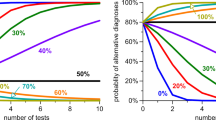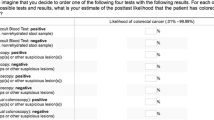Abstract
This study investigated how people integrate base-rate information with information about the accuracy of a diagnostic test when making judgments about the probability a person will develop a disease. Participants were presented nine vignettes of medical cases with three base-rate levels crossed with three levels of the accuracy of the diagnostic test. Supporting our hypotheses, we found that both the base-rate and test-accuracy information influenced the probability judgments. Moreover, the test accuracy by base-rate interaction indicated that the influence of the accuracy of the test on judgments was conditioned by the level of the base-rate information. In contrast to previous research in which participants tended to neglect base-rate information in favor of case-specific information, this study demonstrates that if the baserate information is seen as relevant to the case, it can have considerable and even greater influence than case-specific information on judgments.
Similar content being viewed by others
References
Ajzen, I. (1977). Intuitive theories of events and the effects of base-rate information on prediction. Journal of Personality and Social Psychology, 35, 303–314.
Bar-Hillel, M. (1980). The base-rate fallacy in probability judgments. Acta Psychologica, 44, 211–233.
Einhorn, H.J., & Hogarth, R.M. (1985). Ambiguity and uncertainty in probabilistic inference. Psychological Review, 92; 433–461.
Gigerenzer, G., Todd, P.M., & the ABC Research Group. (1999). Simple heuristics that make us smart. New York: Oxford University Press.
Ginosar, Z., & Trope, Y. (1980). The effects of base-rates and individuating information on judgments about another person. Journal of Experimental Social Psychology, 16, 228–242.
Hinsz, V.B., & Davidson, DJ. (1993). Contextual influences of within subjects designs on base-rate type problems. Paper presented at the meeting of the Society for Judgment and Decision Making, Washington, DC.
Hinsz, V.B., & Tindale, R.S. (1992). Ambiguity and human versus technological sources of information in judgments involving base-rate and individuating information. Journal of Applied Social Psychology, 22, 973–997.
Hinsz, V.B., Tindale, R.S., Nagao, D.H., Davis, J.H., & Robertson, B.A. (1988). The influence of the accuracy of individuating information on the use of base-rate information in probability judgment. Journal of Experimental Social Psychology, 24, 127–145.
Kahneman, D., Slovic, P., & Tversky, A. (1982). Judgment under uncertainty: Heuristics and biases. Cambridge, England: Cambridge University Press.
Kahneman, D., & Tversky, A. (1973). On the psychology of prediction. Psychological Review, 80, 237–251.
Koehler, J.J. (1996). The base-rate fallacy reconsidered: Descriptive, normative, and methodological challenges. Behavioral and Brain Sciences, 19, 1–52.
Lynch, J.G., Jr., & Ofir, C. (1989). Effects of cue consistency and value on base-rate utilization. Journal of Personality and Social Psychology, 56, 170–181.
Lyon, D., & Slovic, P. (1976). Dominance of accuracy information and neglect of base-rates in probability estimation. Acta Psychologica, 40, 287–298.
Tversky, A., & Kahneman, D. (1980). Causal schemas in judgments under uncertainty. In M. Fishbein (Ed.), Progress in social psychology (pp. 49–72). Hillsdale, NJ: Erlbaum.
Wells, G.L. (1992). Naked statistical evidence of liability: Is subjective probability enough? Journal of Personality and Social Psychology, 62, 739–752.
Author information
Authors and Affiliations
Corresponding author
Additional information
Preparation of this article was supported by a National Science Foundation Research Experiences for Undergraduates grant supplement (BCS-9905397) and a National Institute for Mental Health AREA grant (R15 MH63734-01) awarded to the first author. Contributions of the other authors to this manuscript were relatively equivalent so they were listed alphabetically. A portion of this research was presented at the 2003 meeting of the Society for Judgment and Decision Making, Vancouver, British Columbia. We appreciate the comments of Renee Magnan, Ernest Park, and Dana Lawrence on an earlier version of the paper.
Rights and permissions
About this article
Cite this article
Hinsz, V.B., Heimerdinger, S.R., Henkel, J.M. et al. Test-accuracy and base-rate information in the prediction of medical disease occurrence. Curr Psychol 24, 80–90 (2005). https://doi.org/10.1007/s12144-005-1007-8
Issue Date:
DOI: https://doi.org/10.1007/s12144-005-1007-8




